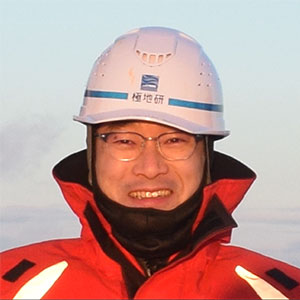Press release with author’s message
— From ArCS II News Letter No.5 —
In ArCS II Newsletter No.5, the authors of articles published in Winter 2021-Spring 2022 contributed their research, thoughts on their research, and future prospects.
*Affiliations are at the time of the newsletter publication.
Low-Cost Drone Offers Opportunity to Expand Data Acquisition Coverage in Polar Regions

Jun Inoue
(National Institute of Polar Research, Meteorology and Glaciology Group)
Meteorological data collected from polar regions is essential for forecasting climate and weather using operational numerical weather prediction (NWPs) models. Radiosondes, one of the instruments in the meteorological observation network, provide an atmospheric vertical profile. Using more radiosondes would improve NWPs but increasing the observation cover and frequency requires significant resources. We have successfully gathered high-quality data comparable to radiosonde observations using a modified commercially available drone, opening doors to improved weather prediction.
| Title | Toward sustainable meteorological profiling in polar regions: Case studies using an inexpensive UAS on measuring lower boundary layers with quality of radiosondes |
| Journal | Environmental Research |
| Published | December 2, 2021 |
| Authors | Jun Inoue, Kazutoshi Sato |
| DOI | https://doi.org/10.1016/j.envres.2021.112468 |
Press Release
Red Snow Phenomena Are a Balancing Act

Yukihiko Onuma
(Institute of Industrial Science, The University of Tokyo)
Red snow is a unique phenomenon caused by blooms of red algae that live on the surface of snow. We have developed a numerical model to predict the occurrence of red snow events. In this study, we found that red snow algal blooms are associated with the duration of snow melt and the timing of new snowfall. Our numerical simulation of snow algal blooming has the potential to be used for the global prediction of future red snow phenomena, which are likely to synchronize with global climate change.
| Title | Global Simulation of Snow Algal Blooming by Coupling a Land Surface and Newly Developed Snow Algae Models |
| Journal | Journal of Geophysical Research: Biogeosciences |
| Published | February 2, 2022 |
| Authors | Yukihiko Onuma, Kei Yoshimura, Nozomu Takeuchi |
| DOI | https://doi.org/10.1029/2021JG006339 |
Press Release
Predicting the Change of the Greenland Ice Sheet Until the Year 3000

Ralf Greve
(Institute of Low Temperature Science, Hokkaido University)
The ice sheets of Antarctica and Greenland are the largest potential contributors to future sea-level rise. Computer simulations are a valuable tool to assess these contributions. Here, we investigated the mass loss of the Greenland ice sheet with our model SICOPOLIS until the year 3000 under the assumption of ongoing climate change until 2100 and a constant climate thereafter. The results show that 21st-century climate change will affect the Greenland ice sheet for many centuries beyond that and can lead to a threatening contribution to global sea-level rise (up to ~ 3.5m) without effective climate change mitigation measures.
| Title | Mass loss of the Greenland ice sheet until the year 3000 under a sustained late-21st-century climate |
| Journal | Journal of Glaciology |
| Published | March 14, 2022 |
| Authors | Ralf Greve, Christopher Chambers |
| DOI | https://doi.org/10.1017/jog.2022.9 |
Press Release
A New Method Using Image Classification AI to Predict Potential Natural Vegetation

Hisashi Sato
(Research Institute for Global Change, JAMSTEC)
A new method using image classification AI to predict potential natural vegetation corresponding to climate (monthly precipitation and monthly mean air temperature of a year) has been developed. This method can estimate potential natural vegetation with ease and precision compared with pre-existing methods. The trained model accurately simulated a global map of current distributions of potential natural vegetation. Then, the trained model was applied to climate scenarios toward the end of the 21st century, predicting a significant shift in global biome distribution under rapid warming trends.
| Title | Predicting global terrestrial biomes with the LeNet convolutional neural network |
| Journal | Geoscientific Model Development |
| Published | April 4, 2022 |
| Authors | Hisashi Sato, Takeshi Ise |
| DOI | https://doi.org/10.5194/gmd-15-3121-2022 |
Press Release
